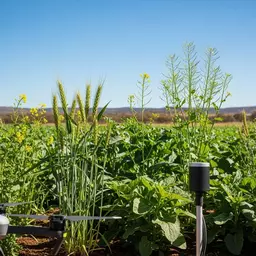Navigating Australia's Biosecurity Resources

In a world where our ecosystems are increasingly at risk, understanding biosecurity is becoming more crucial than ever. A recent statistic reveals that Australia's agricultural sector contributes significantly to the national economy—underscoring the importance of protecting it from pests and diseases. How well do you grasp the dynamics of biosecurity and its implications for food security and environmental health?
What You Will Learn
- Biosecurity is essential for maintaining Australia's unique biodiversity and agricultural resilience.
- Collaboration among government, industry, and research entities is vital for effective biosecurity measures.
- The Australian Government Department of Agriculture, Fisheries and Forestry (DAFF) plays a crucial role in developing biosecurity policies.
- Common barriers to biosecurity policy implementation include lack of funding, stakeholder engagement challenges, and regulatory complexities.
- Case studies of past biosecurity breaches highlight the need for early detection and community involvement in surveillance efforts.
- Investing in research and improving communication strategies are key recommendations for enhancing biosecurity policies.
- Access to authoritative resources and networking at industry events fosters collaboration and knowledge sharing in biosecurity.
Biosecurity Challenges and Policy Improvements in Australia
An overview of the common barriers hindering effective biosecurity policy implementation and key recommendations for enhancement from expert groups. For a deeper dive into foundational concepts, consider understanding biosecurity in Australia.
Common Barriers in Policy Implementation
- ● Lack of Funding: Insufficient financial resources.
- ● Stakeholder Engagement: Difficulty aligning diverse interests.
- ● Data Gaps: Incomplete or outdated information.
- ● Regulatory Challenges: Complex navigation of regulations.
ABSAG Recommended Policy Improvements
- ✓ Increased Investment in Research: Funding for innovative solutions.
- ✓ Improving Communication Strategies: Better public awareness.
- ✓ Streamlining Regulatory Processes: Facilitating quicker response actions.
Understanding Australia's National Biosecurity Landscape
When we talk about biosecurity in Australia, we’re delving into a critical aspect that protects our agricultural systems and natural ecosystems. Biosecurity involves the measures we put in place to prevent the introduction and spread of harmful pests, diseases, and invasive species. Given our unique biodiversity and agricultural reliance, it’s especially important to ensure that these threats are managed effectively. But why is biosecurity so essential for us? Simply put, it safeguards our food supply, our economy, and our environment.
In Australia, the importance of biosecurity cannot be overstated. Our agricultural sector is a significant contributor to the national economy, and any disruption caused by biosecurity threats can have serious repercussions. From the devastating impacts of pests on crops to the potential for disease spread among livestock, we must stay vigilant. This is where the synergy of various stakeholders comes into play, ensuring that we all contribute to a resilient biosecurity framework.
What is Biosecurity and Why is it Important in Australia?
Biosecurity is the practice of managing risks posed by pests and diseases. In Australia, this includes monitoring borders and agricultural practices to prevent incursions. The consequences of neglecting biosecurity can be severe, resulting in economic losses, food shortages, and environmental degradation. Understanding this landscape is crucial for everyone involved in sustainable agriculture, research, and management, including those focused on sustainable pest control.
- Protecting agricultural production
- Safeguarding biodiversity
- Mitigating economic risks
As we engage with biosecurity, we see the interconnectedness of our actions and their effects on the environment. It’s not just about protecting crops or livestock; it’s about preserving our way of life. At Plant Frontier Insights, we’re passionate about fostering this understanding among researchers and professionals alike, ensuring that knowledge is shared and applied effectively.
Key Players in Australia's Biosecurity Initiatives
The landscape of biosecurity in Australia is shaped by various stakeholders, including government agencies, industry representatives, and research entities. Each plays a pivotal role in developing and implementing biosecurity policies. Some of the key players include:
- Australian Government Department of Agriculture, Fisheries and Forestry
- State and territory governments
- Industry associations and farmers
- Research institutions and universities
Collaboration among these groups is essential for fostering a comprehensive approach to biosecurity. By sharing knowledge and resources, we can create a stronger defense against potential threats. At Plant Frontier Insights, we believe that engaging with these players is crucial for advancing our agricultural resilience.
Overview of the Role of the Australian Government Department of Agriculture, Fisheries and Forestry
The Australian Government Department of Agriculture, Fisheries and Forestry (DAFF) plays a central role in our national biosecurity efforts. This department is responsible for developing policies that protect our agricultural sector and managing programs that ensure compliance with biosecurity regulations. Their actions range from inspecting imports to coordinating responses to biosecurity incidents.
Through collaborative projects and public engagement, DAFF works to enhance our understanding of biosecurity issues. They provide vital resources and support to stakeholders, ensuring that everyone has the information needed to contribute effectively. It's a complex task, but one that is fundamental to protecting Australia’s food systems.
Significance of Biosecurity Australia in National Initiatives
Biosecurity Australia serves as the national framework that underpins our biosecurity initiatives. It coordinates efforts across various levels, ensuring that policies are consistent and effective. The significance of this framework lies in its ability to bring together diverse perspectives and expertise to tackle biosecurity challenges.
- Establishing standards for biosecurity measures
- Facilitating information sharing across sectors
- Enhancing public awareness of biosecurity issues
As we look to the future, the role of Biosecurity Australia cannot be underestimated. It provides a clear direction for achieving our goals in agricultural resilience and environmental stewardship. By staying informed and engaged with these initiatives, we can all play a part in securing the health of our ecosystems and food systems.
Pro Tip
Did you know? Engaging local communities in biosecurity initiatives can significantly enhance surveillance and reporting of potential threats. Encourage local farmers and residents to participate in monitoring efforts, as their intimate knowledge of the area can lead to quicker detection and response to biosecurity issues.
Addressing Challenges in Biosecurity Policy Implementation
When we consider Australia's biosecurity landscape, it’s crucial to acknowledge the common barriers that hinder effective policy execution. Many of these challenges stem from the complexity of coordinating across various sectors and the need for adequate resources. It’s a reminder that even with the best intentions, implementing biosecurity measures can be less straightforward than it appears!
Some notable barriers include:
- Lack of Funding: Insufficient financial resources can limit the scope of biosecurity initiatives.
- Stakeholder Engagement: Difficulty in aligning diverse interests among stakeholders often slows down decision-making processes.
- Data Gaps: Incomplete or outdated data can lead to ineffective responses to biosecurity threats.
- Regulatory Challenges: Navigating the complex regulatory environment can deter timely policy implementation.
Addressing these barriers requires collaboration and innovative thinking. I often remind myself and my colleagues at Plant Frontier Insights that overcoming these hurdles is essential for building a resilient agricultural future in Australia.
Case Studies: Lessons Learned from Biosecurity Breaches
Examining past biosecurity breaches provides valuable insights into how we can enhance our policies. Each incident carries lessons that shape future strategies and improve our defenses. For instance, the 2016 Tomato Potato Psyllid outbreak in Australia highlighted the importance of rapid response systems.
Some key lessons drawn from these cases include:
- Importance of Early Detection: Quick identification of threats is crucial in mitigating their spread.
- Community Awareness: Engaging local communities can significantly contribute to surveillance and reporting.
- Inter-agency Collaboration: Effective communication among different government departments can enhance response efforts.
These case studies serve as reminders that while we may encounter setbacks, there’s always room for improvement and adaptation in our approaches. I believe that sharing these experiences fosters a stronger community committed to safeguarding our agricultural landscape.
Insights from the Australian Biosecurity Science Advisory Group on Policy Improvements
The Australian Biosecurity Science Advisory Group (ABSAG) plays a pivotal role in shaping biosecurity policies through research and expert recommendations. Their insights are invaluable in identifying areas that require improvement. During a recent discussion with peers, it became clear that we must leverage these expert opinions to enhance our national strategies, especially when considering plant science advances in Australia.
Some recommended areas for policy enhancement include:
- Increased Investment in Research: Allocating more funds to biosecurity research can lead to innovative solutions.
- Improving Communication Strategies: Better public awareness campaigns can encourage community participation.
- Streamlining Regulatory Processes: Simplifying regulations can facilitate quicker response actions.
Embracing these insights not only strengthens our current policies but also ensures that we are prepared for future challenges. At Plant Frontier Insights, we are committed to sharing these valuable findings to foster collaboration and innovation in the field.
Engaging with Expert Insights and Reliable Resources
In a rapidly evolving biosecurity landscape, having access to authoritative resources is essential for staying informed. Whether you're a researcher, student, or sustainability professional, knowing where to find credible information can empower your efforts in biosecurity.
Some key resources include:
- Government Websites: Official sites like the Department of Agriculture, Fisheries and Forestry provide up-to-date policies and guidelines.
- Research Journals: Access to peer-reviewed articles helps in understanding the latest advancements in biosecurity.
- Industry Reports: Organizations such as Plant Health Australia often publish valuable insights and analyses.
These resources serve as a foundation for engaging with the broader biosecurity community and enhancing our collective knowledge.
Connecting with Experts: Networks and Conferences to Consider
Networking with experts in the biosecurity field is crucial for exchanging knowledge and fostering collaboration. Participating in industry conferences is one of the best ways to connect with like-minded individuals! Events such as the Australian Biosecurity Symposium and various agricultural expos offer great opportunities for learning and collaboration.
Here’s a list of notable networks and events to consider:
- Australian Biosecurity Symposium: Annual event that gathers biosecurity professionals from various sectors.
- Plant Biosecurity Research Initiative: A networking opportunity focused on research advancements.
- Online Webinars: Many organizations offer free webinars on current biosecurity topics and research findings.
Taking part in these events not only enhances your knowledge but also creates connections that can lead to impactful collaborations in the future.
Utilizing Resources from the Australian Academy of Science for Enhanced Knowledge
The Australian Academy of Science provides a wealth of resources and publications focused on biosecurity and related fields. Engaging with their materials is a great way to deepen your understanding of complex topics. From comprehensive reports to educational materials, they offer a plethora of information!
Notable resources include:
- Publications on Biosecurity Research: In-depth insights into the latest scientific findings.
- Workshops and Training Programs: Opportunities to gain hands-on experience in biosecurity.
- Expert Panels: Access to discussions with leading biosecurity experts.
By utilizing these resources, we can bridge the gap between research and practical applications, contributing to a more resilient agricultural future.
Frequently Asked Questions (FAQs)
- What is biosecurity?
- Biosecurity refers to the measures and practices implemented to prevent the introduction and spread of harmful pests, diseases, and invasive species that could impact agriculture, the environment, and human health.
- Why is biosecurity important in Australia?
- Biosecurity is crucial for Australia to protect its unique biodiversity, safeguard its significant agricultural sector, ensure food security, and mitigate economic risks associated with pest and disease outbreaks.
- Who are the key players in Australia's biosecurity initiatives?
- Key players include the Australian Government Department of Agriculture, Fisheries and Forestry (DAFF), state and territory governments, industry associations, farmers, and research institutions.
- What are common barriers to effective biosecurity policy implementation?
- Common barriers include insufficient funding, challenges in engaging diverse stakeholders, gaps in data, and the complexity of navigating regulatory processes.
- What lessons have been learned from past biosecurity breaches?
- Past breaches highlight the importance of early detection of threats, active community involvement in surveillance and reporting, and effective inter-agency collaboration for rapid response.
- How can biosecurity policies be improved?
- Improvements can be made through increased investment in research for innovative solutions, better communication strategies to enhance public awareness, and streamlining regulatory processes for quicker response actions.
Recap of Key Points
Here is a quick recap of the important points discussed in the article:
- Biosecurity is crucial for protecting Australia's agricultural systems, biodiversity, and economy.
- Key stakeholders, including government agencies and research institutions, play essential roles in developing and implementing biosecurity policies.
- Challenges in biosecurity policy implementation include lack of funding, stakeholder engagement issues, data gaps, and regulatory complexities.
- Case studies highlight the importance of early detection, community awareness, and inter-agency collaboration in managing biosecurity threats.
- The Australian Biosecurity Science Advisory Group emphasizes the need for increased investment in research and improved communication strategies.
- Engaging with expert resources and networking opportunities is vital for fostering collaboration and advancing knowledge in biosecurity.
Popular Posts
 As the agricultural landscape in Australia evolves, the role of genetic innovation tools becomes inc
As the agricultural landscape in Australia evolves, the role of genetic innovation tools becomes inc
 As the agricultural landscape in Australia faces mounting challenges, understanding effective crop p
As the agricultural landscape in Australia faces mounting challenges, understanding effective crop p
 As Australia faces growing agricultural challenges, the significance of biosecurity cannot be overst
As Australia faces growing agricultural challenges, the significance of biosecurity cannot be overst
 As we delve into the intricate world of biosecurity, consider this: the health of Australia’s ecos
As we delve into the intricate world of biosecurity, consider this: the health of Australia’s ecos
